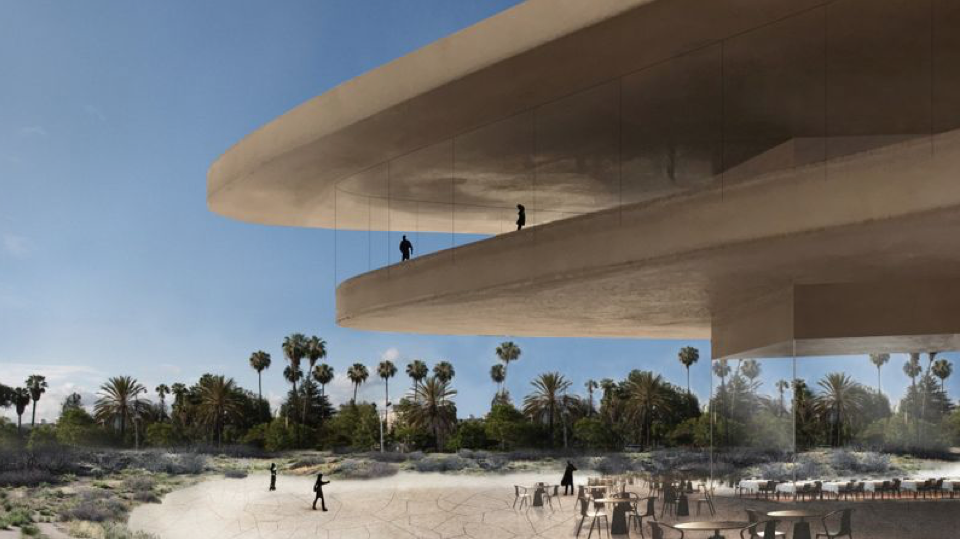CommentsGUEST WORDS—Tuesday April 9, the Los Angeles County Board of Supervisors will vote on a singular new building for the County Museum of Art. Much of LACMA as we know it will disappear under the plan.
William Pereira’s 1965 trio of aloof, fluted modernist boxes, as well as Hardy Holzman Pfeiffer’s much-derided 1986 addition, will perish before the bulldozers, replaced by Swiss architect Peter Zumthor’s pancake-like bridge spanning Wilshire Boulevard.
The new, $650 million design has come under attack in the last few weeks in part because a final environmental impact report revealed that while the price for LACMA’s new home was getting larger, the building was getting smaller. Overall, the museum will shrink by eleven percent, according to the County’s Chief Executive Officer. Some estimates indicate that gallery space will be even more radically reduced, by as much as 30 percent.
Museum Director Michael Govan has defended the smaller museum as a better museum, but no one inside or outside the museum world believes this is anything other than an expedient, a necessary defense of the harsh truth that architects’ dreams are always more costly in reality than on paper. Which is why so many of them remain on paper.
The voices of opposition are describing the Zumthor design as pure folly. Museums do not spend hundreds of millions to lose space; they expand. LACMA, which is the largest encyclopedic museum west of the Mississippi has storehouses stuffed with art that no one ever sees. A less spacious museum will only worsen this predicament, especially if Govan’s desire to dismantle the encyclopedic museum and turn it into some kind of cultural mash-up.
So, why do it? Why, indeed, should the supervisors give the favorable nod today to what seems like such an underdeveloped and over-priced concept?
Alas, the supervisors haven’t been paying attention to the bargain they’re about to enter into. The reason LACMA is shrinking has less to do with rising construction costs than to do with Michael Govan’s insistence that museum goers, no matter where, will not ascend above the first-floor galleries. This edict, which he embossed into the gullible minds of his board of directors and into the velum sketches of his architect, produced a building floating across a major thoroughfare. That’s because, when Zumthor and Govan first presented their one-story elevated black “oil slick” (inaptly named for something they thought had existed at the Tar Pits next door, but never did), they’d encroached on the neighboring park. The Natural History Museum, which owns Hancock Park, cried foul. Govan’s diehard decree had blocked them from going up another story, or two. Stuck with a sprawling one-story building, they had no choice but to go out. And out meant only one thing, spanning Wilshire Boulevard to use LACMA’s parking lot at Spaulding.
Bridges cost boodles of money, and you don’t get much in return. They’re all structure and no building, as if proved by the numbers Christopher Knight unearthed in his call for the Supervisors to void the LACMA plan. As Knight reports, LACMA is paying about $500 per square foot more than any other recent museum – or a total of $170 million extra. That’s what the bridge is costing: 25 percent of the total sum for the new museum. For closer to $480 million, had LACMA simply used the land it has on the north side of Wilshire Boulevard, the citizens of Los Angeles might be getting not only better architecture, but a bigger museum.
But that’s not all. Into this ill-begotten bargain, based on a hollow idea, is thrown even more needless money. Lots of it. LACMA is the most-heavily subsidized museum in the country. It is also one of the most heavily indebted. The proposal the supervisors will vote on today will further beggar LACMA by more than half a billion dollars. The exact figure, which is in the County CEO’s letter urging a yes vote, is $511 million, which the CEO notes, will cost LACMA $17.5 million every year for the next 30 years, to pay off. Between this new debt, added costs of permanently renting office space because the new museum won’t have room for its curators and other staff, and paying off existing debt, LACMA will be pushed to the brink of insolvency.
This self-inflicted wound is entirely avoidable. First, give up on a one-story building. Second, don’t squander the Spaulding parking lot, which the museum bought in the first place as a land bank to cash in on development rights – to build precisely the kind of development the city and county are looking for along the transit rich Wilshire corridor. The parcel is a potential gold mine, if developed, and could generate millions in annual revenue for the museum.
What the supervisors will vote on Tuesday, in short, is a potential fiscal disaster. Instead of getting less for more, they could be getting more for less. When the museum opens in 2023 – if it opens – we can be sure of one more thing. Us museum goers, whether or not we ascend above the first floor elsewhere at LACMA, will also be paying a lot, lot more, for much, much less.
(Greg Goldin is the co-author of Never Built Los Angeles, and Never Built New York, and is currently working on an exhibition at the Museum of the City of New York on the history of Central Park. From 2000 to 2012 he was the architecture critic at Los Angeles Magazine.)














